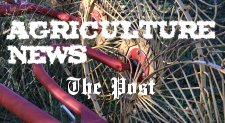Looking at Hay Needs for 2015 and 2016
March Is When You Plan for Next Winter
 Most producers this time of year are not thinking about hay needs for next winter, but rather they wonder whether they will have enough hay to finish out this winter. However, March is a good time to evaluate what will be needed in terms of feed resources for the following winter.
Most producers this time of year are not thinking about hay needs for next winter, but rather they wonder whether they will have enough hay to finish out this winter. However, March is a good time to evaluate what will be needed in terms of feed resources for the following winter.
“March is an ideal time to evaluate hay needs for next winter,” said Andrew Griffith, a University of Tennessee Extension agricultural economist. “Producers are well aware of the quantity of hay they fed their livestock the past several months and they can approximate the quantity of hay they will have left when spring grass emerges.” With this knowledge, the economists says producers are in a good position to estimate their feed expenses for next winter.
Griffith encourages producers to download the UT Extension Hay Calculator from the UT Department of Agricultural and Resource Economics: economics.ag.utk.edu. The calculator is a Microsoft Excel–based spreadsheet that can help in determining the quantity of hay a producer needs to secure prior to winter feeding. It bases estimates on hay storage method, feeding method, bale size and number of days of feeding. Once the quantity of hay is calculated, then a producer can use that information to determine the quantity of hay to produce or purchase.
“Knowing a good estimate of the quantity of hay that will be needed next winter could prove to be an effective cost management strategy,” said Griffith. “Prior planning of hay needs will allow a producer additional time to identify additional hay resources if the traditional resources fall short of expectations. Such planning will allow producers to identify fields and pastures available for rent for hay production. Additionally, it provides a cattle producer who purchases hay an opportunity to identify hay brokers or other producers marketing hay.”
Hay harvest is not too far around the corner and plenty of hay will be available immediately after harvest. However, as time passes, the availability of hay will dwindle and the cost of such hay could increase, the economist said. “Users of hay are encouraged to evaluate needs and secure supplies early to guarantee feed needs are met.”
For information on forage production, visit the UT Beef and Forage Center website at utbfc.utk.edu. From there, you can explore the “Forages” tab at the top of the screen. You may also contact your local county UT Extension Office.
The UT Institute of Agriculture provides instruction, research and outreach through the UT College of Agricultural Sciences and Natural Resources, the UT College of Veterinary Medicine, UT AgResearch, including its system of 10 research and education centers, and UT Extension offices in every county in the state.











